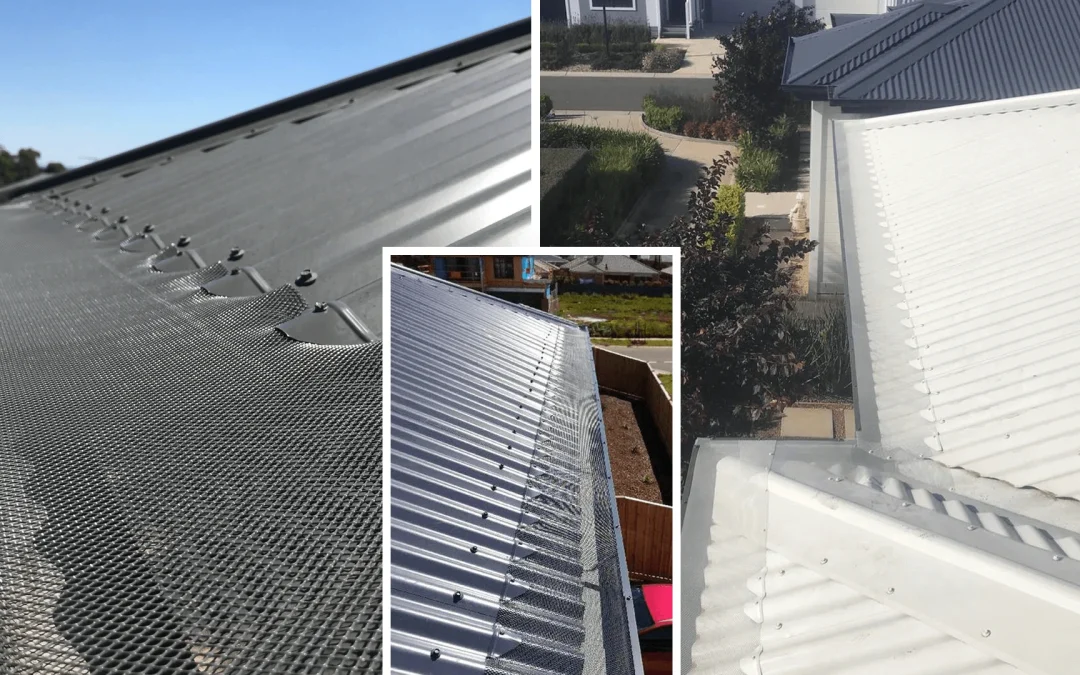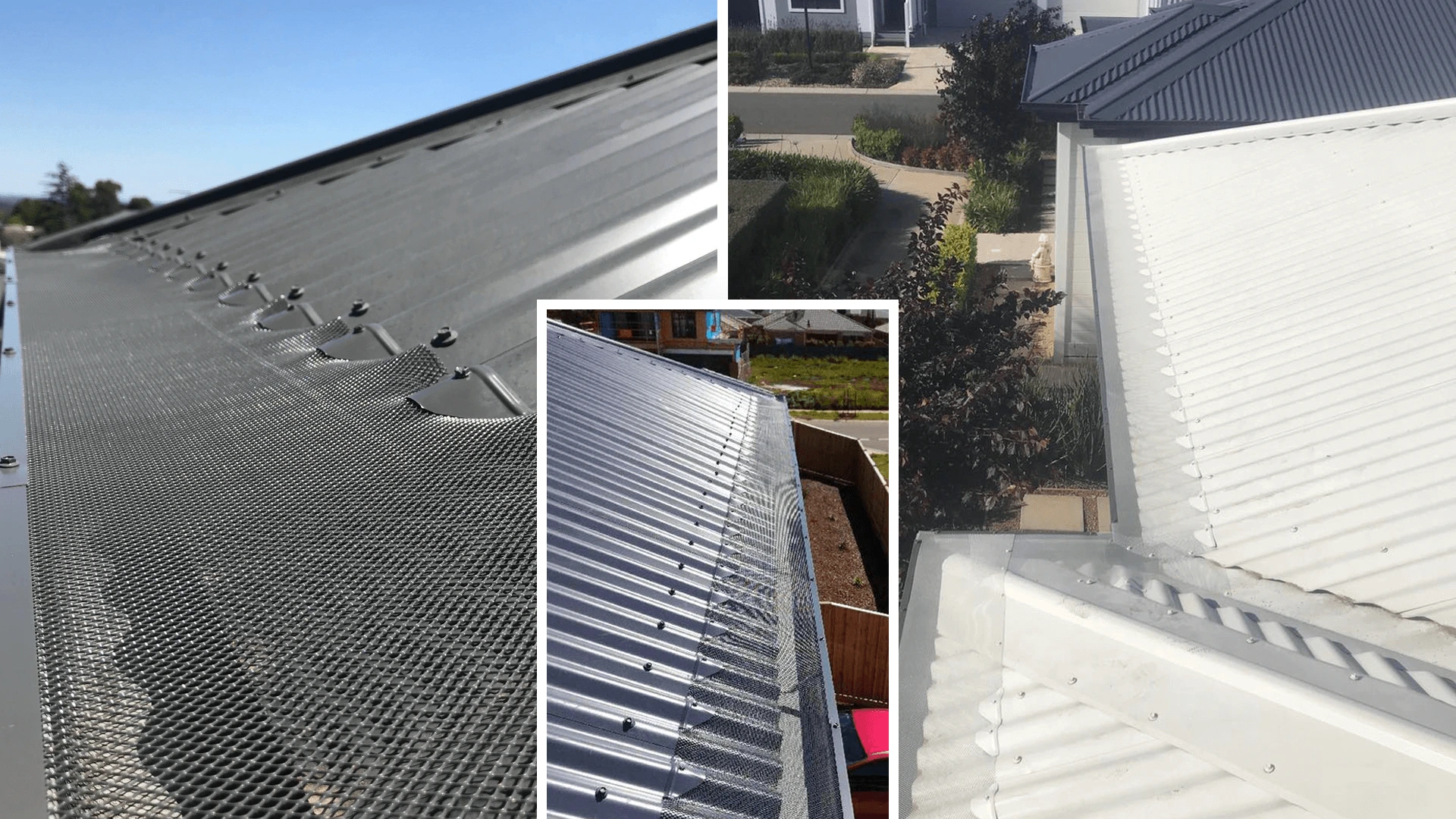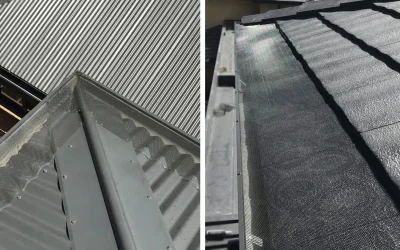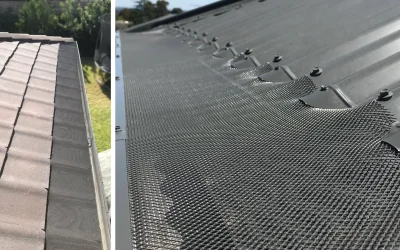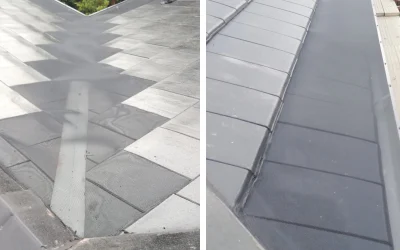Why flat and low-slope roofs are different
On steep roofs, gravity is your friend. Leaves roll off, water accelerates, and downpipes clear quickly. On flat and low-slope roofs, water lingers, and debris settles. The result? More risk of ponding, overflow at parapets, and stress on joints and membranes. Australia’s building guidance is crystal clear on capacity and overflow: each downpipe should serve manageable lengths of guttering, with planned overflow paths that direct water away from the building fabric. Flat roof drainage succeeds when fall, capacity, and overflows are all considered together and when you keep the system free flowing with leaf guard mesh.
The anatomy of low-slope drainage
Box gutters do heavy lifting on flat roofs. Often hidden between roof planes or behind parapets, they move large volumes but are unforgiving when blocked. A box gutter guard helps stop leaf litter, seed pods and bird nesting material from choking outlets and sumps.
- Rainheads and sumps manage surges. Standards call for box gutters to discharge via a sump or rainhead, with suitable overflow so intense rainfall doesn’t back up under flashings. Rainhead guards keep coarse debris out, so overflows work as intended.
- Internal outlets and dome grates (on membrane roofs) reduce blockage risk. A protective grate or outlet strainer is your last line of defence; pairing it with upstream debris-blocking gutter mesh just makes sense.
The takeaway is simple: design gives water a safe exit; Gutter Guards preserve that design between clean-ups.
Choosing Gutter Guards for flat and low-slope roofs
Not all protection systems behave the same on low falls. Here’s what to weigh up when you’re comparing gutter protection options for these roofs:
- Integration with the roof edge and parapets
Integrated, continuous gutter mesh systems are preferred for complex roof geometries because they create a sloped plane that sheds debris while feeding water into the gutter line. That helps stop “leaf shelves” at parapets and reduces maintenance on wide box gutters. - Mesh aperture and flow
Large volumes of water demand open area. For flat-roof catchments, choose high-flow gutter mesh that screens twigs and leaves while maintaining throughput at outlets and rainheads. Avoid ultra-fine apertures unless you’re targeting small debris (and confirm they won’t throttle flow under local rainfall intensities). - Compatibility with membrane and metal roof details
On metal roofs, saddles and fastenings must suit the profile (e.g., Klip-Lok®, Trimdek®, corrugated). On membrane roofs, ensure the mesh interface doesn’t compromise the waterproofing system and that dome outlets remain accessible for inspection. Commercial gutter guard solutions and installation methods should respect these details. - Overflow planning remains king
Even with leaf guards, design for the storm you expect. Use compliant falls, downpipe spacing, and overflow routes via rainheads or scuppers. Remember, Gutter Guards prevent blockages; they don’t replace correct hydraulics. - Maintenance and access
Aim for a system that reduces ladder time and makes inspections straightforward. A good gutter protection system will lengthen intervals between clean-ups and make any necessary checks faster and safer.
What the codes and guides emphasise
- Capacity: Compliant fall and downpipe ratios help avoid surcharging. In general housing guidance, each downpipe should serve finite lengths to maintain effective fall and capacity for typical design storms. Downpipe spacing matters just as much as mesh selection.
- Overflows: Box gutters should discharge via sumps or rainheads with defined overflow paths. Installing a gutter guard doesn’t remove the need for these safety valves—it helps keep them functional by stopping debris at the entry point.
- Box gutter form: Avoid problematic shapes and ensure details follow accepted practice; some authorities warn that incorrect shapes (e.g., V-shaped internal gutters) can lead to damage. Box gutter guards complement, not replace, good geometry.
How Gutter Guards improve outcomes on flat roofs
1) Fewer blockages at critical points
Leaves don’t just fall into the middle of a gutter; they accumulate where flow converges—sumps, rainheads, and internal outlets. Screening the run keeps the system open during peak rainfall, so water reaches the overflow rather than creeping under flashings. That means fewer emergency call-outs and calmer storm performance.
2) Lower maintenance burden over time
By keeping coarse debris out, Gutter Guards lengthen the time between clean-ups. When you do need a service, the task is lighter and safer. That’s practical value on buildings where roof access is controlled or scaffold is costly.
3) Better rainwater harvesting quality
A cleaner catchment means cleaner water into your storage system. While you’ll still use first-flush or filtration devices as appropriate, a screened gutter line reduces organic sludge in the system. (This is a practical side benefit many property owners appreciate.)
CPR Gutter Protection: what you can expect
If you’re comparing suppliers, CPR is a local name many homeowners consider for Gutter Guards in Australia. Public information about CPR indicates:
- Australian-made gutter guard options and expert installation.
- Bushfire-protection compliant offerings referenced in their social presence. (Mesh choice and install method matter, especially in ember zones—always confirm the product spec for your site conditions.)
- 30-year warranty claims cited in public listings. (Check current terms directly when you get a quote.)
- Free gutter cleaning before installation mentioned on third-party profiles.
- Over two decades of experience noted across local directories.
Note: Always verify inclusions, materials and coverage in your written quote. The right choice of aluminium gutter guard, gutter guard mesh, aperture size and fixings should match your roof type, local environment and drainage design.
A quick decision grid for flat and low-slope roofs
Goal: keep water moving and prevent ponding or backflow.
Levers: fall, capacity, overflow—and cleanliness via Gutter Guards.
Use this checklist when scoping your project:
- Roof type & catchment
- Measure contributing roof areas, note any valleys feeding box gutters, and confirm minimum falls. Flat roof guttering lives or dies by these numbers.
- Gutter form
- Identify box gutters, scuppers and parapet details. Plan where an integrated gutter mesh will sit and how debris will shed off the roof edge.
- Outlets and overflows
- Confirm sumps, rainheads and dome grates are correctly sized and have compliant, visible overflow paths. Rainhead design is not optional on box gutters.
- Mesh specification
- Choose high-flow gutter guards with the right aperture for your debris profile. Balance screening with hydraulic performance at design rainfall.
- Materials & fixings
- Match to roof (metal or membrane), salt exposure, and maintenance plan. Quality aluminium gutter mesh is common; stainless may be selected for specific conditions.
- Maintenance plan
- Even with Gutter Guards, schedule periodic inspections—especially before the wet season and after major wind events.
Practical tips for installers and owners
- Don’t over-tighten mesh over wide box gutters. Allow for thermal movement and avoid oil-canning or ponding on the mesh surface itself.
- Keep outlets accessible. Guards should enhance, not block, access to sumps, rainheads and dome grates.
- Respect the fall. In low-slope situations, even a few millimetres per metre matters; it’s the difference between clean flow and lazy ponding.
- Protect transitions. Valleys that discharge into box gutters need considered detailing; integrated valley gutter guards prevent “leaf dams” at the mouth.
- Confirm compatibility in ember-prone locations. Where ember guard gutter mesh is relevant, aperture size and material selection should align with local requirements. (Your installer can advise and specify accordingly.)
When Gutter Guards pay for themselves on flat roofs
- Buildings with mature trees nearby: constant leaf fall overwhelms flat-roof outlets without screening.
- Wide box gutters behind parapets: out of sight means out of mind—until it overflows internally.
- Rainwater harvesting setups: cleaner gutters, cleaner tanks, fewer surprises during the first big summer storm.
Bringing it all together
Flat and low-slope roofs succeed on three pillars: sound hydraulics, reliable overflow, and ongoing cleanliness. Gutter Guards address that third pillar, helping your design perform the way it was intended through wind, blossom drop and storm grit. Couple a well-specified gutter protection system with compliant falls, correctly spaced downpipes, and rainheads that actually overflow to the outside, and you’ve built resilience into your roof. That’s peace of mind you can see every time dark clouds roll in.
Thinking about next steps?
If you’re weighing options, it’s worth speaking with an experienced installer who understands flat roof gutter guard installation, box gutter guard detailing, and local code requirements. Public sources indicate CPR offers Australian-made solutions with professional installation, and you can validate current product specs, mesh types and inclusions directly in your quote. The right setup will be tailored to your roof, your trees, and your rainfall—so the only thing your flat roof collects is compliments, not puddles.
FAQs
1. Do Gutter Guards actually help on flat and low-slope roofs?
2. Will Gutter Guards stop blockages at rainheads and sumps?
3. Do box gutters need rainheads or sumps even if I install guards?
4. How often should I inspect gutters after installing Gutter Guards?
5. What mesh aperture makes sense on flat roofs?
6. Can Gutter Guards improve rainwater harvesting outcomes?
7. Are there special considerations for membrane or internal-drain roofs?
Social Share:
Related Posts
Gutter Guards and Pest Control: Blocking Possums, Mynas & Rats Humanely
Ever heard that strange scrabble above the ceiling at 2am? Or found a wedge of sticks…
The Smart Way to Keep Your Gutters Clear with Gutter Guards
Keeping gutters clear is one of those home maintenance tasks that often gets neglected…
Are Your Gutter Guards Ready for Australia’s Intense Summer Rains?
As the Australian summer approaches, bringing with it the promise of intense rains…
